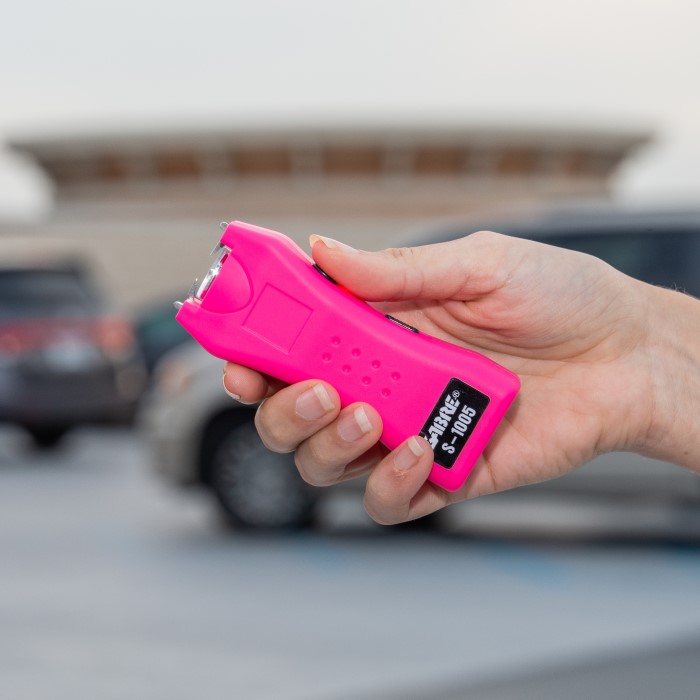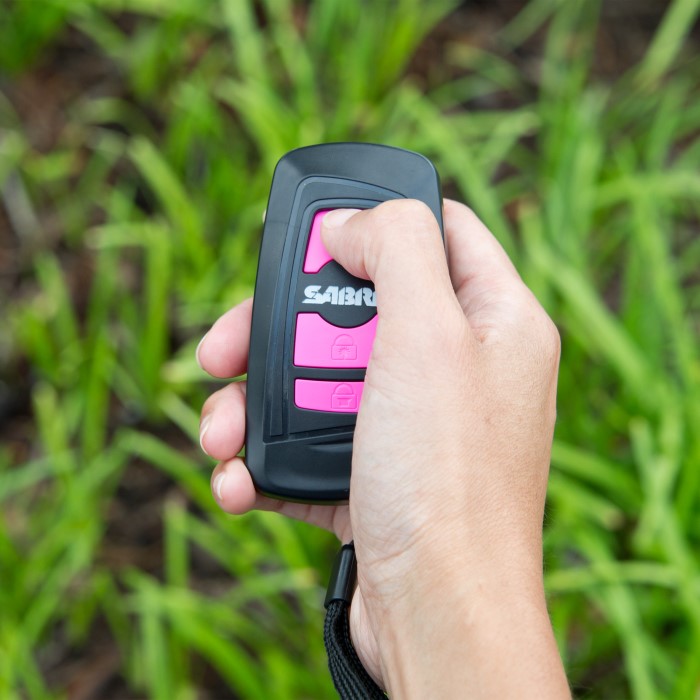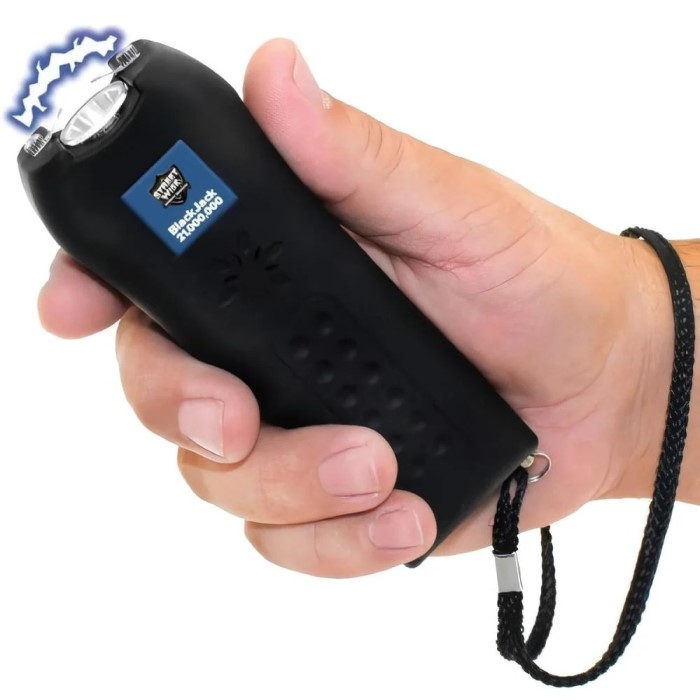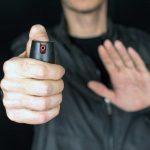In today’s world, personal safety is a paramount concern for many individuals, prompting them to explore various self-defense tools. Among these, stun guns and tasers are two popular options that offer non-lethal ways to incapacitate an assailant. However, a common question arises: stun gun vs taser— which self-defense tool is better for you? This article aims to delve into the differences and similarities between these two devices, their legal considerations, effectiveness, and much more to help you make an informed decision about your personal safety.

Understanding the Basics of Stun Guns and Tasers
What is a Stun Gun?
A stun gun is a handheld self-defense device designed to deliver an electric shock to a potential attacker. It requires direct contact to administer the shock, which disrupts the electrical signals between the brain and muscles.
- Mechanism of Action: When the stun gun makes contact, it releases a high-voltage current that temporarily incapacitates the attacker by causing muscle spasms and disorientation.
- Voltage Levels: Most stun guns operate in a range from 50,000 to 1 million volts, but the effectiveness depends not just on voltage but also on the design and quality of the device.
- Duration of Effect: The incapacitating effects are usually temporary, lasting from a few seconds to several minutes, enough time for the user to escape.
What is a Taser?
On the other hand, a taser is a more advanced self-defense item that can immobilize an assailant from a distance. It shoots two wires that connect to the device, allowing for incapacitation at a range typically between 15 and 30 feet.
Mechanism of Action
- Dart Firing System: When a taser is activated, it fires two small darts that are propelled by compressed gas. These darts are equipped with barbed tips designed to penetrate clothing and attach securely to the target.
- Wire Connection: The darts are connected to the main taser unit by long, thin wires. This enables the device to deliver electrical pulses to the target from a distance, typically ranging from 15 to 30 feet, depending on the model.
- Electrical Shock Delivery: Once the darts make contact with the target, the taser sends a controlled electrical shock through the wires. This shock disrupts the electrical signals between the brain and the voluntary muscles of the body, leading to a temporary loss of muscle control.
- Targeting Specificity: The design of the taser allows for precision targeting, ensuring that the electrical shock is delivered effectively to incapacitate the attacker without causing permanent injury.
Voltage Levels
- Operating Voltage: Tasers typically operate at about 50,000 volts, which is lower than many stun guns, which can reach voltages of 1 million or more. However, the voltage itself is not the only measure of effectiveness.
- Effectiveness of Delivery: The manner in which a taser administers electrical shocks is crucial to its effectiveness. Rather than relying solely on high voltage, tasers utilize a specific waveform to maximize the impact on the body, making them more effective at incapacitating a target.
- Safety Profile: While tasers operate at lower voltage levels compared to stun guns, they are designed to incapacitate quickly without causing permanent harm, making them a preferable choice for law enforcement and personal protection.
Duration of Effect
- Typical Shock Duration: The electrical shock delivered by a taser generally lasts for around 5 seconds. This brief duration is strategically designed to incapacitate the target while minimizing the risk of serious injury.
- Physiological Impact: During the duration of the shock, the target experiences involuntary muscle contractions, effectively immobilizing them and preventing them from attacking or fleeing.
- Time for Escape: Although 5 seconds may seem short, this duration is usually sufficient for the user to either escape the situation or call for help. This window allows for a swift response to a potential threat while keeping the user safe.
- Repeat Applications: If necessary, the taser can be fired multiple times without substantial recovery time for the user, as long as it is within the device’s operational range and the darts remain effective. This adds to the device’s flexibility in a self-defense situation.
Key Differences Between Stun Guns and Tasers
When considering stun gun vs taser, a few key differences should influence your choice.
Method of Operation
- Direct Contact vs. Distance:
- Stun Guns: Must be applied directly to the attacker, which can be dangerous if the assailant is aggressive.
- Tasers: Can incapacitate someone from a distance, reducing the risk of personal injury to the user.
Legal Implications
- Stun Guns: In many jurisdictions, stun guns are legal but might be restricted in specific locations, such as schools or government buildings. Always check local regulations.
- Tasers: Often have stricter regulations and may require permits or specific licenses in certain areas. Verify the laws in your state before making a purchase.
Usability
- Ease of Use:
- Stun Guns: Require less training and are typically more straightforward in design. Just turn it on and apply it directly.
- Tasers: May require some practice to aim and effectively fire, especially under stressful conditions.
Legal Considerations
Understanding the legal framework surrounding stun guns and tasers is crucial. Laws vary widely from state to state and country to country.
General Regulations
Legal Status
- State Variability: The legal regulations surrounding stun guns and tasers vary widely from one state to another. This can create a complex legal landscape for individuals interested in owning or carrying these self-defense tools.
- Permissive States: In some states, stun guns and tasers are readily permitted with minimal restrictions. This may include laws that allow for their open or concealed carry without the need for permits.
- Restrictive States: Conversely, several states impose strict regulations regarding the ownership and carrying of stun guns and tasers. These regulations might include specific requirements for use, limitations on where they can be carried, and comprehensive licensing procedures.
Check Local Laws
- Importance of Verification: It is crucial to always check the local laws regarding stun guns and tasers before purchasing or carrying one. Laws can frequently change, and staying informed about the latest regulations is essential.
- Potential Consequences: Being unaware of or ignoring applicable laws can have serious repercussions, including substantial fines, confiscation of the device, and even criminal charges. Ignorance of the law is not generally accepted as a viable defense.
- Resources for Guidance: Individuals can explore various resources to verify local laws, including government websites, legal aid organizations, and local law enforcement agencies. These resources can provide up-to-date information on the legal status of stun guns and tasers in specific areas.
Special Licenses
- Permit Requirements: In certain jurisdictions, individuals may be required to obtain special permits to legally own or carry stun guns and tasers. This is particularly common for tasers, which are often viewed as more potent self-defense tools.
- Classification of Devices: Tasers are frequently classified as firearms or weapons in some areas, resulting in stricter legal scrutiny and regulatory requirements compared to stun guns. This classification can influence ownership criteria and legal consequences for misuse.
- Application Process: Obtaining a special license may involve completing an application, undergoing background checks, and sometimes fulfilling training requirements. Properly following these procedures is essential for legal ownership and usage.
Carrying Stun Guns and Tasers
Many potential users ask, is it legal to carry around a stun gun? Generally, the answer is contingent on the relevant state laws. However, most states allow responsible individuals to carry stun guns for personal protection.
Effectiveness of Stun Guns and Tasers
When determining which self-defense option is better, it is essential to consider the effectiveness of each tool.
Target Situations
- Context Matters: For crowded places or scenarios where close contact may be overly dangerous, a taser may provide better protection.
- Personal Experience: Factors like personal training and familiarity with the devices will affect their effectiveness in a real situation.
Potential Risks
- Stun Guns: The primary risk is getting too close to an attacker while attempting to use the device, which can turn dangerous quickly.
- Tasers: Although used from a distance, they might not be effective if the darts miss or fail to deploy correctly.
Frequently Asked Questions
Is it legal to carry around a stun gun?
Yes, in many states it is legal to carry a stun gun, but restrictions may apply. It is essential to understand the laws in your specific area to avoid legal issues. Always consult local law enforcement or legal resources for guidance.
What is the best taser for a woman?
The best taser often depends on individual needs and preferences. Compact and lightweight models, such as the Taser Pulse, are popular among women for their ease of use and portability.
Can a stun gun be lethal?
Generally, stun guns are designed as non-lethal self-defense tools. However, if misused or if used against vulnerable individuals with certain medical conditions, they could potentially cause serious harm.
Conclusion: Making the Right Choice
In conclusion, choosing stun gun vs taser for personal safety involves considering various factors, including the context of use, legal implications, and personal comfort with the devices. Each has unique advantages and disadvantages that can influence your decision. By understanding their mechanisms, legal standing, and intended use, you can make an informed choice that best suits your needs.
Staying informed is crucial. Knowledge of both devices empowers you to strategize effectively for your safety. Additionally, practical training on your chosen device enhances your ability to respond to potential threats. Ultimately, the best self-defense tool is the one you feel most comfortable using effectively and safely.
By weighing the information presented, you can enhance your personal safety strategy and confidently navigate situations where self-defense might be necessary. Remember, preparation and knowledge will always serve as your best allies in self-defense scenarios.





